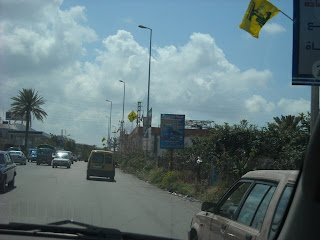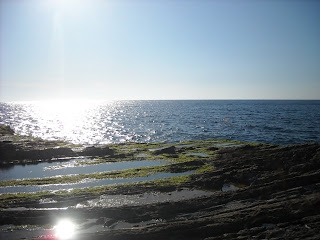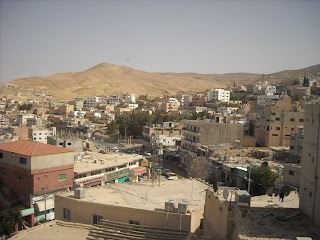ANYWAY
On April 15th my friends and I left Amman to travel to Beirut, Lebanon. We checked into the airport, exchanged our Jordanian Dinars for Lebanese Lira (1500LL=$1US), and had a marvelous lunch of Pizza Hut at the airport before the flight on Royal Jordanian. The flight was only about an hour long, and really wasn’t bad at all. The reason we flew from Amman to Beirut and didn’t take the overland route is because the overland route is either through Israel or Syria. You can’t get into Lebanon from Israel, and the Syrians make it especially difficult for Americans without visas to pass through their border by harassing them and purposefully delaying them so that most Americans hoping to go to Syria are either turned away for not having visa or lose several hours. If you want to avoid this trouble at the border, you need a Syrian visa, which would me require mailing my passport to their consulate in the US and having it mailed back me in Egypt before I left for the trip. In case you haven’t heard, Syria and the US are not on the best of terms.

My parents were a little hesitant about me visiting Lebanon, and most people that read the news will understand why. In 2006 Israel fought a war against the Shiite militant group Hezbollah in Lebanon, and this war include Israel bombing parts of Lebanon’s largest city and capital, Beirut. In May of 2008, Hezbollah took over parts of the city traditionally not under their control, and blockaded the road to the airport. This is the same airport we would be flying into. There haven’t been any terrorist attacks in Lebanon since a few terrorist attacks in Tripoli in July 2008, and many people feel that the country is incredibly stable right now due to a new power-sharing agreement within the government.
Anyway, when we landed in Beirut, we were picked up by a driver that worked for my friend Jessica’s extended family in Lebanon. We would be staying in an apartment that this family owned but was not currently using, and would also be driven to our various destinations in Lebanon by employees working for this family. On our way from the airport, I noticed that there were heavily armed soldiers on many street corners, including some with armored vehicles, which reminded me of Cairo. We also saw these banners that were found on almost every billboard on the main highway leading from the airport:

That would be a Hezbollah banner. The crossed out words are “your Lebanon,” “our Lebanon,” “their Lebanon,” and it just says “Lebanon” in the center. The text to the left literally says “the one homeland for all of its sons.”
From the airport we went to the apartment in the outskirts of Beirut that we would be staying in for the next few days, and I have to say it was probably the nicest apartment I will ever stay in. From the balcony, there was an amazing view of the surrounding hills.

After settling in our apartment, the first place we visited was the American University in Beirut. AUB used to be a study abroad option at my school, but it has been suspended since the 2006 war with Israel. When we visited, I was very jealous that AUB had a nice view of the Mediterranean, a good amount of greenery, and was located in the heart of Beirut.


However, if I had the option to study abroad at AUB and did so, I don’t think I would’ve learned much Arabic at all or as much about Arab culture. Beirut doesn’t feel too much like an Arab city like Cairo does, which was noticeable right away, and explains why Beirut is called “The Paris of the East.” While the primary language of Lebanon is Arabic, most people speak English and French very well, and French appears on signs as much as Arabic to the point that it feels you’re in a European city. The US dollar is also almost as widely accepted as Lebanese Lira, and most places will tell you how much you owe in both currencies. The people in Beirut dress much more liberally, as Lebanon is 40% Christian, and even the Muslim population seems to dress much more liberally than they do in Egypt. Alcohol and bars are found with ease in Beirut, and it is known for its nightlife. In terms of geography, Lebanon was a lot greener than Egypt, and it rained a few times while we were there, not something I’m used to from living in Egypt. Mountains were also almost always visible, and it’s possible to go skiing up in the snowy peaks of these mountains and then to drive a few hours to be on beaches with palm trees.
After visiting AUB, we went to the place where my friend Jessica’s extended family lived, which is the former French Embassy. More or less a mansion complete with tennis courts, inground pool, and automated driveway gate, we met her extended family and their friends there, who took us to a Lebanese restaurant. This Lebanese meal would be our first of many, and it provided enough food to completely fill everyone and then some. First, hors d’oeuvres and pita bread to eat them with were brought out, such as hummus and tabouli, which is finely chopped parsley, scallion, tomatoes, and other herbs. Then, slightly more substantial dishes and some meats came out, and the bread was refilled every time it was emptied. While we were all more or less full at this point, then the actual meat dishes came out, which we couldn’t finish. After dinner we went to a couple of Lebanese bars, where I got to try the Lebanese beer, Almaza. It was pretty good, although relatively heavy. All of the bars we visited were in an area called Gemayze, which contains streets filled with bars, all relatively small but very nice on the inside.

I didn't take this picture, I just found it online
The next day we drove to a town called Byblos on the Mediterranean Coast, which is the oldest continuously inhabited town in the World since its founding around 5000 BC. We spent most of our time in Byblos at a Frankish Crusader castle that was also located next to some Roman ruins. Interestingly enough, some parts of the Crusader castle were made with the Roman ruins. The area was absolutely beautiful, and it had an amazing view of the surrounding hill villages and the Mediterranean.




After visiting Byblos it started to pour, and we got a lunch that also consisted of a huge amount of Lebanese food, almost identical to the meal of the previous night. After lunch we visited two Maronite churches in the mountains (Maronites are Lebanese Christians that are actually associated with the Roman Catholic Church). Driving through the mountains in the rain and fog was not a sight I expected to see in the Middle East, and it reminded me of footage I’ve seen from South America more than anything. That night, we more or less had snacks for dinner, and went out to Gemayze again.
The next day we went up high into the mountains to see the famous Cedars of Lebanon. The Cedar of Lebanon is found as a symbol everywhere in the country, most notably their flag.

I didn’t know that the Cedars grew so high in the mountains, so we were driving for a couple hours just to get to the top of some of immensely high mountains. Eventually, we started to see snow on the side of the road, and soon enough, there was snow everywhere. At the top of the mountain, snow covered everything, and it was actually snowing at the time. I also saw some ski schools and a small ski lift, which made me wish we planned to go skiing, since I would have loved to say I went skiing in Lebanon. However, I was only wearing a track jacket, jeans, and sneakers, so I was ill prepared for the snow enough as it was. We found the Cedar Forest, and walked around in the snow without a footpath. The trees and forest were absolutely beautiful, although by the end I was wet and freezing.



After we got out of the snowy area, we ate a lunch consisting of dough covered in cheese, kind of resembling pizza. We also visited the museum of the Lebanese American poet and artist Khalil Gibran. I hadn’t heard of him before this visit, but I still found the museum, which was mostly an art museum, interesting.

View as we descended the mountain
After we descended the mountain, we traveled to Tripoli in North Lebanon. There were even more soldiers and armored vehicles in Tripoli, probably due to the fighting there last year. The only location in Tripoli we visited was its massive 12th century Crusader Castle, which was a lot of fun to explore as there were many corridors that just seemed to go on and on. Since it was a Friday (the Muslim holy day), most stores and other locations in Tripoli were closed, so we returned to Beirut after we left the Castle. We didn’t really do anything that night except for eating snacks while enjoying American movies on the TV in the apartment.



The next day started by visiting Saida, which is south of Beirut. As we drove through South Beirut, we saw more Hezbollah banners, as the area is known as a Hezbollah support base. However, after a short drive we were in Saida, where we visited its Crusader Castle actually located right on the Mediterranean Sea. There, we explored the castle and got to see how blue the Mediterranean was.


After visiting Saida’s markets and buying some souvenirs, I was surprised that we were traveling even further south. Our driver told us we were going to visit the Roman ruins in a city called Tyre, which I remembered was pretty far south in Lebanon. For those that don’t know, South Lebanon is more or less Hezbollah controlled, so I knew I was in for an interesting experience. If I recall, the exact moment I knew we were entering South Lebanon was when we passed a large Lebanese army checkpoint that had to check all of our passports, which is something I hadn’t seen until then. After we left this checkpoint, we immediately began noticing Hezbollah support signs everywhere.

All of those yellow flags you see are Hezbollah flags.

This is a poster commemorating three famous dead members of Hezbollah. The top one in the glasses is Subhi al-Tufayli, the first secretary-general, killed by an Israeli air strike in 1992. The bottom one with the hat is Imad Mughniyeh, who was one of the most notorious terrorists alive until being killed by a car bomb in 2008 and had a $5 million bounty on his head. I don’t know who the guy on the right is.

This is a banner with Hezbollah flags on it on the way to Tyre. The guy on the left is Hassan Nasrallah, the current leader of Hezbollah who has his picture everywhere in Tyre and South Lebanon. The guy on the right is Nabih Berri, the current Lebanese Speaker of Parliament and the head of the Shi’a Amal movement. The text says “with unity builds the homelands.”
After a while we passed a large UN checkpoint, and from then on UN trucks, and armored vehicles were found everywhere. UN forces have been in Lebanon in some form or another for decades apparently, but seem to be concentrated in the South. It was a little odd being around UN forces, all wearing their trademark blue helmets and berets with different countries inscribed on their uniforms. After arriving in Tyre, the first place we visited was some Roman ruins, which were located right on the Mediterranean and had a nice colonnade walk to the sea with an original mosaic path.

Then we visited Cana, which is where Jesus is said to have performed his first miracle of turning water into wine. It was located on a hill that gave some beautiful views of the surrounding area.


We then visited more Roman ruins in Tyre, which are some of the best in the World. The ruins had a massive hippodrome, or racetrack.

And it also had a massive arch.

After this we went and had lunch in a resort’s restaurant, which began with someone checking our car for bombs as we drove into the parking lot. When we got into the parking lot though, we noticed that there were several UN trucks outside with “UN Observer Group Lebanon” on the license plate. When we went inside to eat another large lunch consisting of various Lebanese dishes, we noticed that a large number of French UN soldiers were sitting at the next table.

After that, we drove back to Beirut, and had the same night as the previous one.
The next day was a Sunday, which we believed to be Maronite Easter Sunday. We thought this meant that everything would be closed and we wouldn’t have a driver, so we decided to just walk around Beirut and would have to rely on cabs. We didn’t have a good experience with this though, as the first cabbie we hired had a strong resemblance to Jabba the Hutt and tried to rip us off. After the bad ride, we walked along the Mediterranean until we came to Beirut’s Pigeon Rocks and hung out there for a while.


We then walked around more and ate lunch at a small chain we frequent in Cairo, Euro Deli. Interestingly, it only has locations in Cairo, Beirut, Montreal, and Tokyo. After this, we walked around Beirut some more in search of souvenirs, but most stores were closed. While we thought this day was Maronite Easter, it turned out to just be a regular Sunday, as Easter was the previous Sunday. We then hired a cab to take us to a restaurant, which was also a bad experience as the cabbie refused to leave us alone until we paid him his price, and attracted the attention of several bystanders in the process. This made me miss cabs in Cairo, where you pay what you think is appropriate at the end of the ride and usually walk away when the driver demands more. We ate at a quiet Italian restaurant for dinner, and had a low-key night.

Random Beirut Picture
The next day we would be flying out at night, so we wanted to spend our last day in Lebanon just relaxing at a beach. After a while, we found a nice public beach located along a rocky cove. It was very rocky there, not sandy, but there were some rocks large enough to lay on, which resulted in me getting some pretty bad sunburn. The swimming and laying in the sun was all very nice until I sliced my foot open on a rock in the water. We left soon after this, as the cut was really bad and required some immediate treatment. However, I was fine enough to not go to the hospital and to catch my flight later that night. We were back in Cairo by 11:00 that night after about an hour flight and an hour cab ride from the airport, and resumed classes the next day.





























